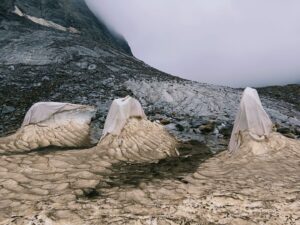Abstract/Description
In June 2022, we monitored snow topography changes and preferential ablation for 10 days on a subarctic mountain snowpack in the Shár Shaw Tagà Valley (Yukon, Canada), using a ground-based terrestrial laser scanning system. Our objective was to capture high-resolution, hourly time-series data on snow height variations. However, the results revealed an unexpected diurnal pattern in snow surface elevation, characterized by consistent nighttime decreases and daytime increases. This pattern was not observed in control measurements on nearby boulders, suggesting that the diurnal changes were not caused by misalignment or instrumentation error but were instead linked to snow surface properties. We hypothesize that two potential mechanisms could explain these anomalous observations: (1) the LiDAR’s 905 nm laser measurements may have been influenced by near-infrared sunlight reflected off the snow surface, with the angle of reflection changing throughout the day, or (2) diurnal variations in the snow surface’s liquid water content due to melting and refreezing cycles altered the laser’s interaction with the snow. These findings align with previous studies highlighting the sensitivity of LiDAR measurements to snow grain size and liquid water content under marginal melting conditions. This observation raises broader concerns for snow studies that rely on similar LiDAR systems. Considering the hypothesis (1): Drone-based LiDAR measurements may face comparable biases as the sensor’s angle and solar position vary during flights, potentially affecting snow surface measurements without being explicitly recognized. Additionally, studies utilizing daily or periodic LiDAR surveys might inadvertently overlook such biases due to insufficient temporal resolution, resulting in unvalidated or inaccurate snow depth data. Correction based on relative position of the LiDAR to the Sun may resolve or attenuate this bias. On the other hand, the hypothesis (2) emphasizes the importance of supplementing LiDAR measurements with additional observation techniques, such as photogrammetry, ground-truthing or surface energy budget, to validate LiDAR results and ensure robust data interpretation. This study underscores the indispensable role of in-situ fieldwork and continuous monitoring in identifying potential biases and ensuring the reliability of remote sensing techniques for studying snow processes.


